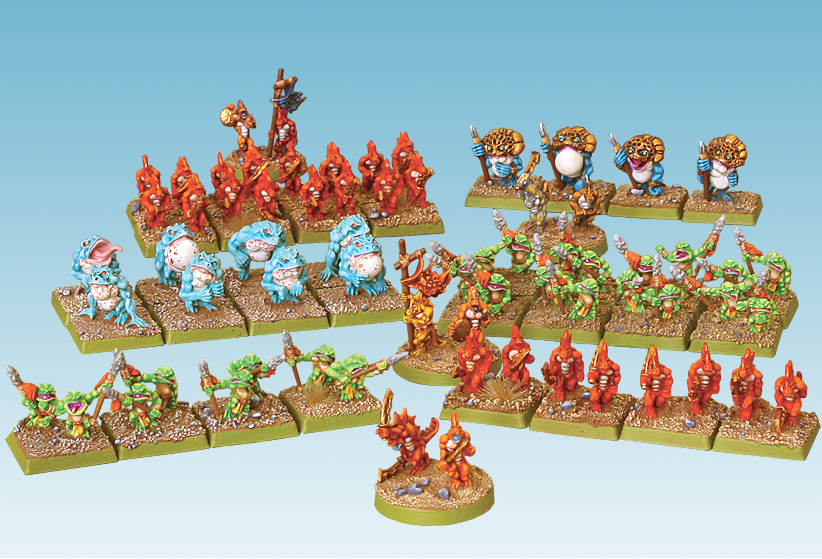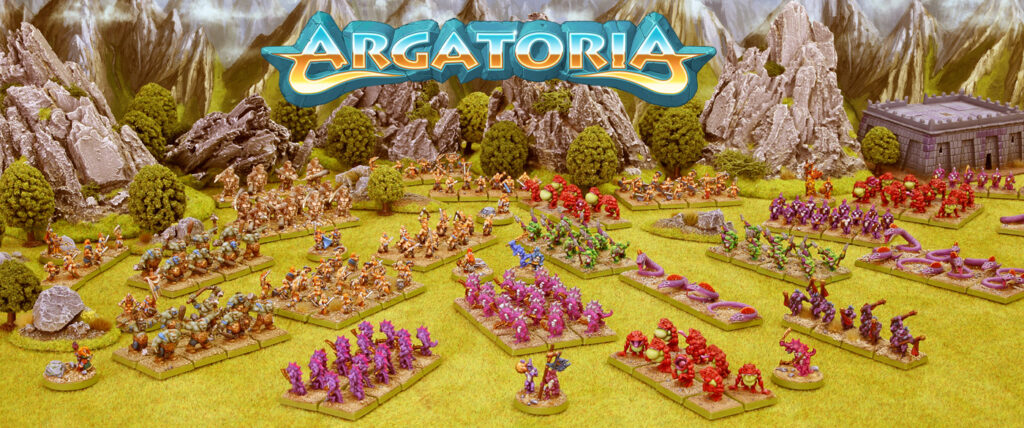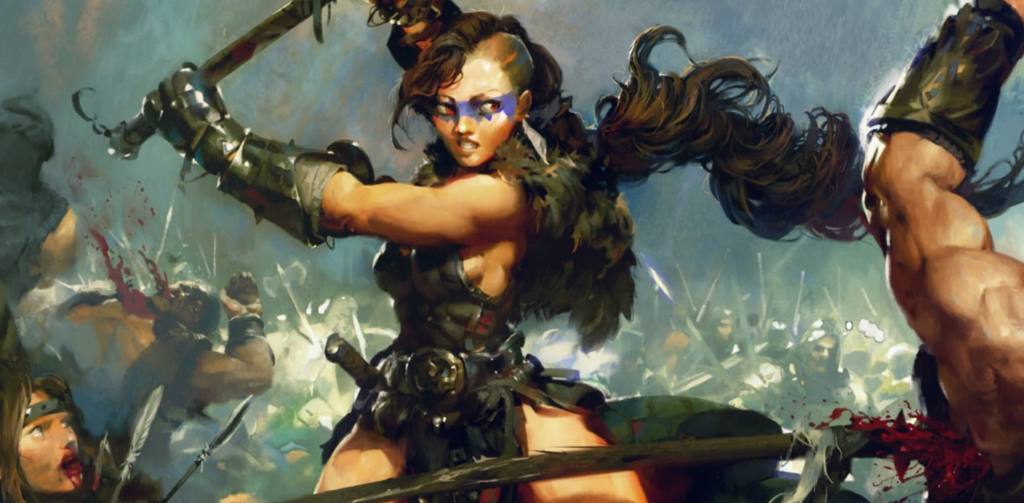This is one of these games where you fall in love with or hate it. When you hate it, you hate it enough to even never try it. It’s niche for sure, but the niche should appeal to a lot of wargamers! Then why didn’t you know this game before we started talking about it?! Let’s have a chat, you and me…

Do mind that at the time of writing this blog, I have played half a dozen times and fell in love with it. If you see any errors in ruling, please let me know, we all learn here!
Who makes Argatoria
Ever heard of Spellcrow? That Polish company that made a lot of conversion bits for that wargame in the 41st millennium? Yeah, that one… that titan from Nottingham that just destroyed a couple of armies you dearly paid for in their new 4th edition. Anyhow, Spellcrow. They started making wargames already since 2011 and have 2 nice stable miniature wargames now. One skirmish and one mass battle game. This mass battle game is called Argatoria and that’s what we are going to talk about.
Argatoria, the backdrop
So, why did I say that this niche would apply to every wargamers in the known universe? Well… barbarians galore, need I say more? When I need to explain this game to a person, I always say that this game is pulled right out of a Conan Movie. That dark barbaric fantasy setting with a lot of big swords, peak performance humans and loads of sword and sorcery. This is exactly what you are going to get when you play a game of Argatoria, complete with undead, witches, big fantastical units and lizards roaming the battlefield.
This backdrop needs to have a story, and that is the legacy of Argatea. In the beginning of the legacy, we see Argatea being raised by the tribe leader Thargun, and there were only people living in relative barbaric peace. Traitors arose within the ranks of the tribe and rotted the tribe from within. One day Thargun went to war and never came back, eventually forcing Argatea to flee to the hills. There she trained and became the ferocious leader that would unite the tribes. This was until she disappeared and the once mighty tribe she led shattered into smaller factions.
These are the factions one gets to play in-game, all aligned with different gods for different magic and blessings. There is much more to the story, but we have to keep it short to get to the cool part of this chat we have.
10 mm madness on the kitchen table
One of the big benefits of the game, is that it plays on a 10 mm scale. Since the scale is way smaller that the 28 mm scale variants, you measure in cm instead of inches. There is also the difference in base type when looking at regular, rare or unique units and heroes/ leaders. The leaders have round bases, to quickly find them on the field. The normal units have square bases and are fielded in regiments.

This means the units are minuscule, but also quite fast to paint. You can have a half unit painted in an evening if you use a form of contrast or speedpaint.
The game plays in units, which for their size are made up of 1 row of 4 units, 2 rows of 4 units or 4 rows of 4 units. Every base of normal infantry units has 2 models on a 20 mm base, the large infantry has 1 unit on the base. There are some slightly bigger units, which are on 25 mm bases. Monsters like the Forest Dragon or Elephanton each have their own base sizes and a whole unit is just 1 model.
As you see, this game is rather small, but can take up the big boys in numbers of units! Where the 28 mm variant for instance only has 11 units on the field, this game has a lot more units for the players to wreck through, but it also depends on unit size of course. A 1250 point game could easily have 20+ units on the field! This makes the game a spectacle to see.
Randomness
Did you ever play a battle that goes exactly like you wanted it? This game emphasizes on the randomness of battle and how you adapt to that randomness.
The game is a “I go you go” type game, but with a twist. Every time a player starts their turn in the round (called cycle) they roll 2d6, where the lowest of the 2 dice is the amount of units you must move. This has a result of 1 to 6 units to move in one turn. It could be that one player may move 5 units and the other just one.
The same goes with the actual movement. Taking infantry as an example, they have a standard movement of 10 cm, but a 1d6 extra cm for a normal move and 2d6 for a charge. You aren’t allowed to pre-measure in this game. When you fail the needed distance of the charge, you may only move the normal distance of 10cm. This could end up disastrously close into the charge range of the enemy unit and be fatal.

There are no stuck phases besides the ones in the cycle. When you charge a unit, everything is resolved in that turn up until casualties. After every unit has moved, the cycle enters a new phase and there will be determined how many casualties actually end up being bloodpoints.
Bloodpoints are the VP’s of Argatoria. When reaching a predetermined amount, the game ends immediately with a winner. If you have scenario’s still unfinished, too bad. This is to indicate the casualties suffered and inability to fight on to make a chance to win the battle.
Factions
There are at the moment of writing 6 factions, each having their own background. 3 of them are human, 3 of them well… not human…
Arox and Sorgax: Reptilian in nature, but where one lives underground, the other lives above ground. The Arox are portrayed as having bright and warm colors like yellow, red and greens. Sorgax players usually paint their models in colder colors like blue’s, purples and such. This portrays the devotion to star gods and living underground.
Sheol Morg: The great evil in this game. They have 3 distinct ways to play. A classic mix of undead, beasts and demons or a leader that caters to one of the 3 variations. Huge beasts, loads of bigger units and skeletons.
Dirandis: Hunters from the cold North, hunting the lands of Argatoria for bigger prey and other tribes that stand in their way. They have yeti’s, half giants and more of the bigger unstoppable units. Did I name the Elephanton already? (hate that thing like I hate my ex-wife!!!)
Gaeldor: Closely connected to the lands, these units are build up of barbarians, forest creatures and the forest itself. Dragons, treemen and spider riding amazons.
Vaendral: The sons and daughters of the great harlot. They mostly charge drunk into battle, attracting the attention of weird creatures and cultists that appreciate the bloodshed. They don’t have shrines, but arenas where the blood is sacrificed to the gods in hope of more war.

So, how does Argatoria play?
Basically, it plays like a light version of Warhammer, but with more beer and pretzels fun. The only thing you need to know, is how to calculate the amount of dice needed to roll in attacking. This means the game is easily picked up and played. Prepping for a game is also easy, since you can snap off the models from the sprue (please use cutters), and glue them to the base. The rest is based on the hobby aspect of wargaming.
The rule books are also a big pro! You can buy the PDF’s on Spellcrow’s own site for about 2 euro and more rules and errata is being published via magazines. The physical books can be bought via shops that resell the product, like our shop. Still the prices are really affordable.
Looking at a starter set, you get set back about 50 euros. For each additional unit, it’s a line or a full unit varying from 8 to 32 euros at our shop.
Conclusion…
This means that Argatoria is not only fun to collect, paint and play, but it’s also a relative cheap game to get into. This means that as a wargamer, you have no single reason to not play this game at least once! Beware tough, it’s highly addictive to play, and you can play more games in an evening. Getting revenge is settled in the same evening of the defeat.
What are you still waiting for, get playing, painting and let me know what you think about it. MOVE THEM MINIS!